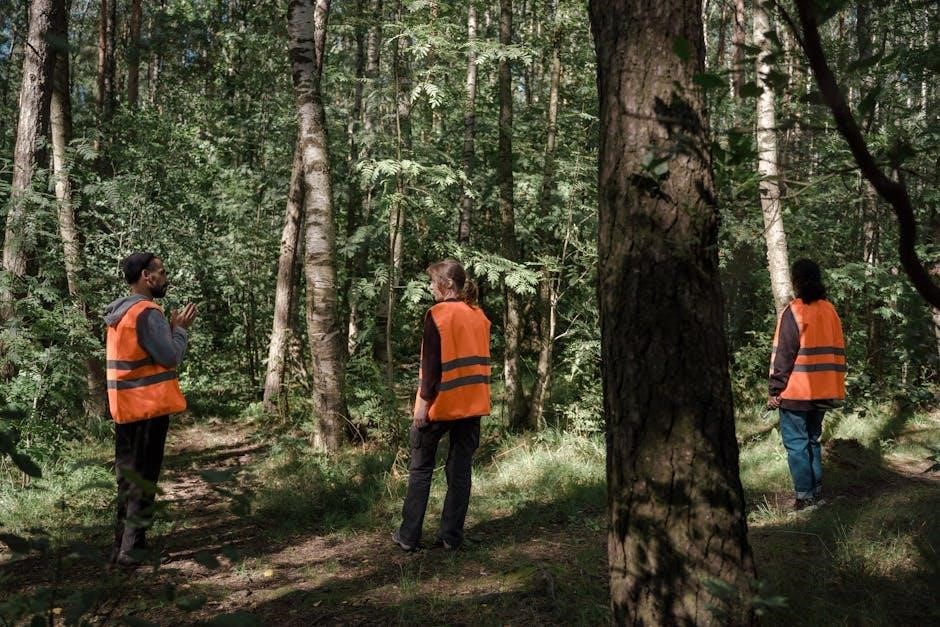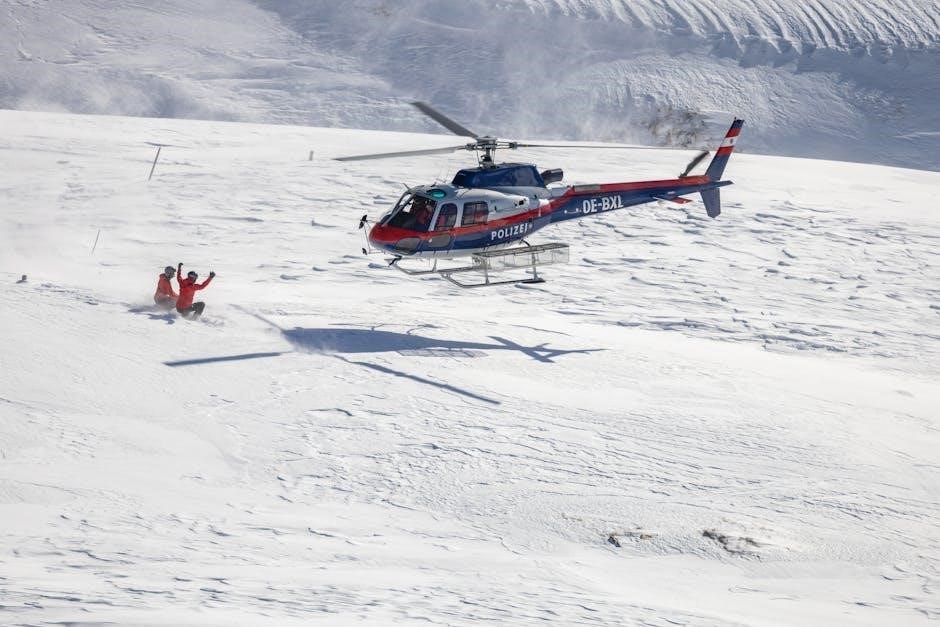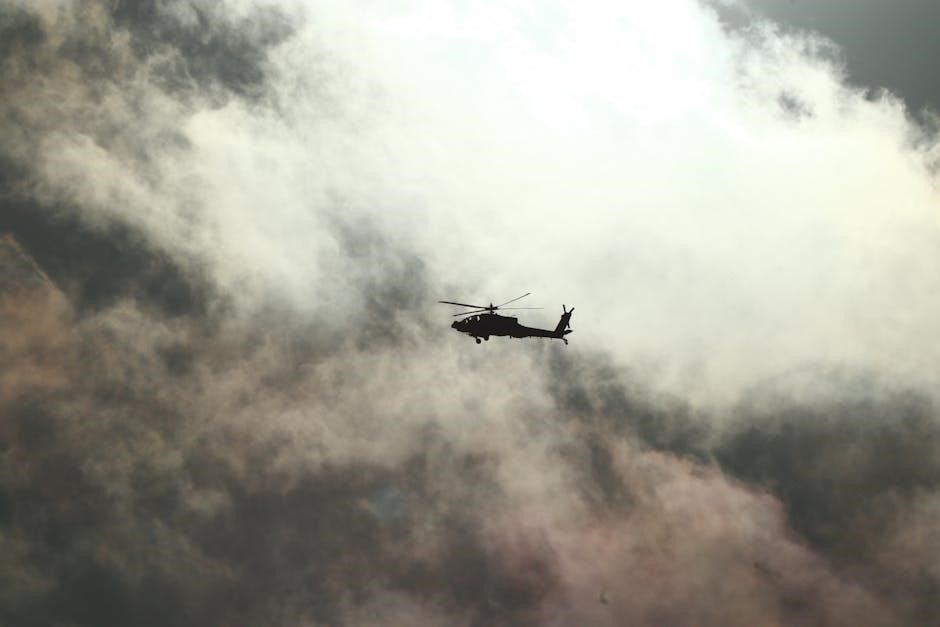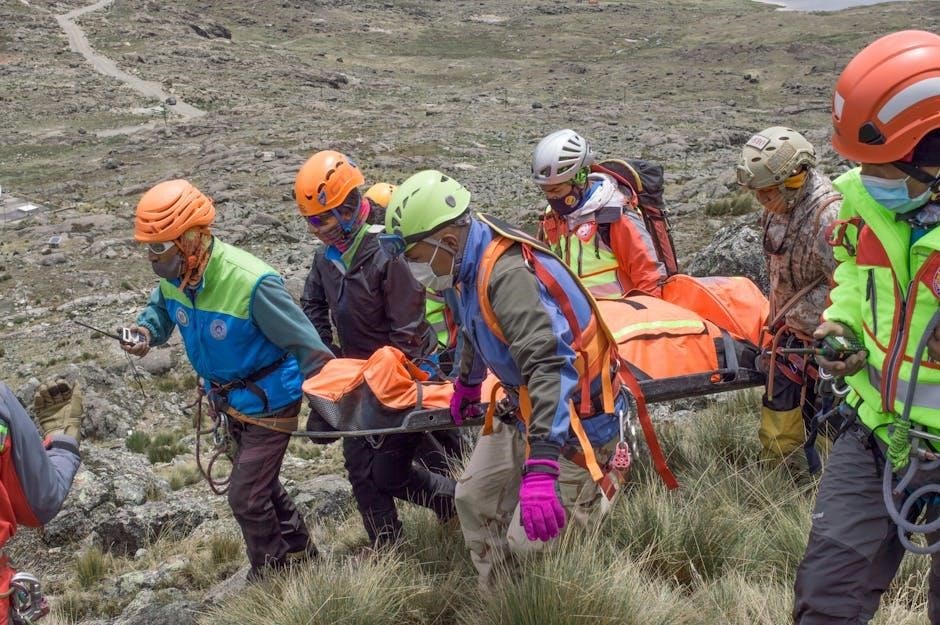Search and Rescue (SAR) is a critical emergency response system designed to locate and assist individuals in distress. It integrates skilled personnel, advanced technology, and specialized resources to save lives and reduce suffering during crises.
1.1. Definition and Scope of Search and Rescue (SAR)
Search and Rescue (SAR) is a lifesaving operation aimed at locating, assisting, and recovering individuals in distress or dangerous situations. It encompasses a wide range of activities, including disaster response, medical emergencies, and missing person cases. SAR operations are conducted in various environments, such as urban areas, wilderness, and water bodies, and involve specialized teams, equipment, and strategies. The scope of SAR extends beyond rescue to include prevention, preparedness, and recovery efforts, ensuring the safety and well-being of affected individuals. It requires coordination between multiple agencies, including emergency services, volunteers, and community organizations. By integrating advanced technology, trained personnel, and effective planning, SAR missions play a critical role in saving lives and reducing the impact of crises.

1.2. Historical Development of SAR Operations
The origins of Search and Rescue (SAR) operations can be traced back to ancient times, with evidence of organized rescue efforts during natural disasters and military conflicts. Modern SAR evolved significantly during World War II, where systematic search and rescue techniques were developed to locate missing personnel. The 1960s and 1970s saw the establishment of formal SAR organizations and standardized protocols, leveraging advancements in technology and communication. Today, SAR operations are a global effort, involving specialized teams, drones, and advanced sensors. Historical milestones include the creation of the U.S. National Park Service’s SAR program in the 1970s and the development of the Federal Emergency Management Agency’s (FEMA) Urban Search and Rescue (USAR) system in the 1980s. These developments have shaped SAR into a highly coordinated and effective lifesaving discipline.
Core Principles of Search Operations
Effective search operations rely on systematic planning, resource allocation, and coordination to locate missing persons or items efficiently. Advanced techniques, including air scent and grid searches, ensure thorough coverage while minimizing risks.
2.1. Search Planning and Coordination
Search planning and coordination are essential for effective SAR missions. They involve defining objectives, assessing risks, and allocating resources based on the situation’s complexity. Skilled coordinators ensure that teams are deployed strategically, minimizing overlaps and maximizing coverage. Proper planning includes mapping the search area, estimating timeframes, and establishing communication protocols. Coordination with multiple agencies and stakeholders is crucial to avoid conflicts and enhance efficiency. Advanced tools like GPS and thermal imaging are often integrated into plans to improve accuracy. Continuous monitoring and adaptability are key, as conditions can change rapidly. A well-coordinated effort ensures that search operations are both safe and successful, ultimately leading to the swift location and rescue of those in need.
2.2. Search Techniques and Strategies
Search techniques and strategies are critical to the success of SAR missions. Common methods include systematic grid searches, air and ground sweeps, and the use of trained search dogs. Thermal imaging and drones are increasingly deployed to locate missing persons in challenging terrains. Effective strategies involve dividing the search area into sectors, assigning tasks based on resource availability, and prioritizing high-probability zones. Communication between teams is vital to avoid duplication of efforts and ensure thorough coverage. Adaptive strategies are employed as new information emerges, such as witness accounts or changing weather conditions. The integration of technology, like GPS tracking and real-time data sharing, enhances accuracy and efficiency. These techniques and strategies ensure that search efforts are methodical, efficient, and tailored to the specific scenario, maximizing the likelihood of a successful outcome.

Rescue Operations Fundamentals
Rescue operations involve specialized techniques to safely extract individuals from dangerous situations. Trained personnel use advanced equipment and strategies to minimize risk and ensure successful outcomes. Precision and speed are critical in rescue missions to preserve life and prevent further harm, requiring meticulous planning and coordination.

3.1. Rescue Prioritization and Risk Assessment
Rescue prioritization and risk assessment are critical components of effective rescue operations. These processes ensure that resources are allocated efficiently, focusing on the most critical situations first. The prioritization often involves evaluating the severity of the incident, the number of individuals in distress, and their specific needs. Risk assessment, on the other hand, identifies potential hazards to rescuers and those being rescued, ensuring operations are conducted safely. This dual approach balances urgency with caution, minimizing risks while maximizing the likelihood of successful outcomes. By systematically evaluating each scenario, rescue teams can make informed decisions, adapting strategies as conditions evolve. This ensures that rescue efforts are both effective and sustainable, ultimately saving lives and reducing long-term consequences.
3.2. Rescue Equipment and Tools

Rescue equipment and tools are essential for conducting successful search and rescue operations. These tools are designed to handle various scenarios, from urban disasters to wilderness rescues. Common equipment includes ropes, pulleys, winches, and harnesses for rope rescue operations, as well as thermal imaging cameras and drones for locating missing persons. Hydraulic rescue tools, such as the “Jaws of Life,” are used to extricate victims from collapsed structures or vehicles. First aid kits, stretchers, and communication devices are also critical for providing immediate medical care and coordinating efforts. Specialized tools like water rescue gear and avalanche transceivers are employed in specific environments. The selection of equipment depends on the nature of the emergency, ensuring rescuers can operate safely and effectively. Proper training in the use and maintenance of these tools is vital to maximize their effectiveness in life-saving situations.

Safety Protocols in Search and Rescue
Safety protocols are crucial to ensure the well-being of rescuers and survivors during SAR operations. These include risk assessments, use of PPE, and clear communication strategies to minimize hazards and ensure effective teamwork.
4.1. Personal Protective Equipment (PPE)
Personal Protective Equipment (PPE) is essential for safeguarding SAR personnel from environmental and operational hazards. Common PPE includes helmets, gloves, safety glasses, and fire-resistant suits. Respiratory protection, such as masks or breathing apparatuses, is used in hazardous environments. Proper footwear ensures stability and traction on uneven terrain. Reflective vests enhance visibility, reducing the risk of accidents. Communication devices, like headsets or radios, are also crucial for maintaining contact during missions. The selection of PPE depends on the nature of the rescue operation, whether it’s urban, wilderness, or disaster-related. Regular training on PPE usage ensures that rescuers can operate safely and effectively in high-stress situations.

4.2. Hazard Identification and Mitigation

Hazard identification and mitigation are critical components of search and rescue operations, ensuring the safety of both responders and victims. Potential hazards include unstable structures, inclement weather, and exposure to harmful substances. Teams conduct thorough risk assessments to identify these threats and develop strategies to minimize them. This may involve stabilizing environments, using specialized equipment, or coordinating with other emergency services. Continuous monitoring is essential, as conditions can change rapidly. Effective communication and training enable teams to recognize and respond to hazards proactively. Technology, such as drones and sensors, aids in detecting risks, while collaboration with experts enhances mitigation efforts. Documenting hazards and strategies improves future operations, ensuring safer and more efficient rescues.
Advanced Topics in Search and Rescue
Advanced SAR topics include cutting-edge technologies like drones and AI, specialized training modules, and international cooperation strategies to enhance rescue efficiency and safety in complex scenarios.
5.1. Use of Technology in SAR Missions
Technology plays a pivotal role in modern SAR missions, enhancing efficiency and accuracy. Drones equipped with thermal imaging cameras quickly locate missing persons in remote or disaster-stricken areas. AI algorithms analyze vast datasets to predict survivor locations, optimizing search efforts. GPS tracking devices enable real-time monitoring of rescue teams, ensuring safety. Advanced communication systems maintain connectivity in challenging environments, while software tools streamline mission planning and coordination. Additionally, robotic systems assist in navigating dangerous terrains, reducing risks to human rescuers. These technological advancements collectively transform SAR operations, making them faster, safer, and more effective in saving lives during critical situations.
5.2. Psychological Aspects of Search and Rescue
The psychological aspects of search and rescue (SAR) missions are often overlooked but are crucial to the success and well-being of both rescuers and survivors. Rescuers operate in high-stress environments, facing life-or-death decisions and the emotional weight of uncertain outcomes. This can lead to mental fatigue, anxiety, and long-term psychological trauma. Survivors, too, experience profound stress, fear, and disorientation, which can impede their ability to assist in their own rescue. Effective SAR operations require psychological support systems, including counseling and stress management for rescuers. Additionally, understanding the mental state of survivors helps rescuers employ compassionate communication and techniques to build trust and cooperation. Addressing these psychological dimensions ensures a more holistic and effective response to emergencies, benefiting both rescuers and those in need. Proper psychological care is essential for sustaining the resilience of SAR teams and improving mission outcomes.